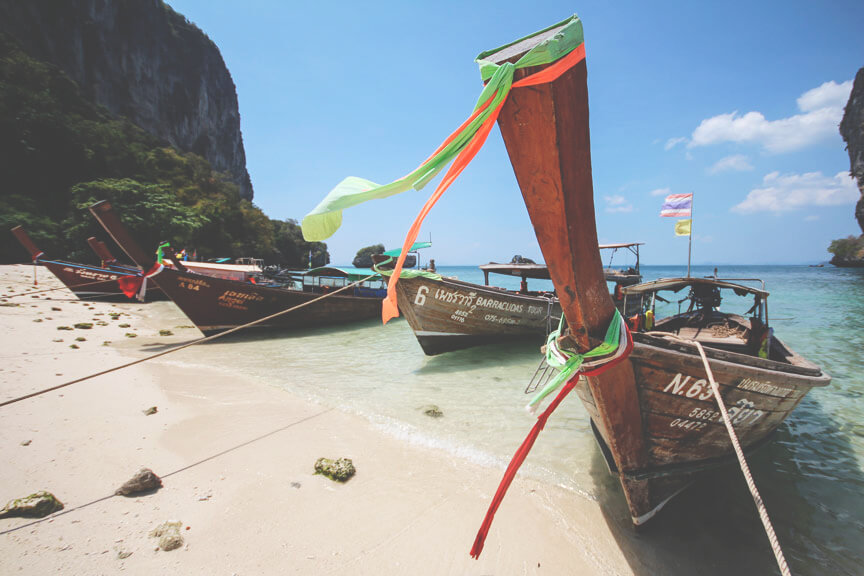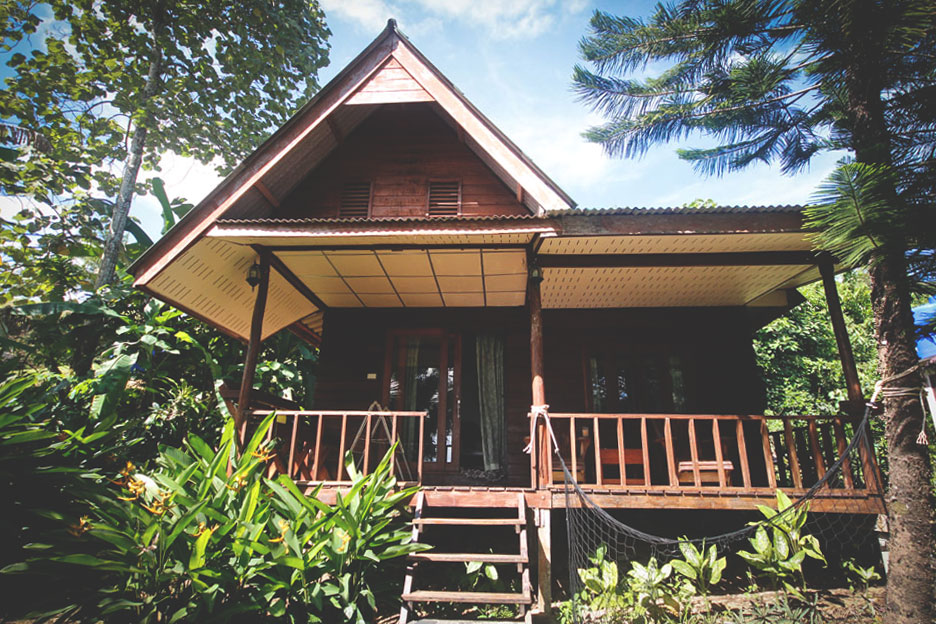Thailand is one of the most popular countries in Asia. In 2017 alone, the country welcomed almost 37 million tourists. Crazy, isn’t it? Thailand simply offers the full spectrum and is perfect for a beach holiday. We spent almost four months in the country, visiting many amazing islands and cities. We fondly remember our wonderful time in Thailand.
In the following article, you’ll learn everything about the currency in Thailand, where and how you can exchange money, what costs to expect, and which travel credit card we recommend for Thailand. You’ll also learn everything about withdrawing money in Thailand. If you still have questions, you can simply leave a comment below this post.
- Currency in Thailand
- Withdrawing money in Thailand
- Exchanging money locally
- The best credit card for Thailand
- Prices in Thailand
- More tips for you
- The best travel guides
Currency in Thailand
In Thailand, you pay with the Thai Baht (THB). Currently, you get around 34 Baht for 1 Euro (two years ago, we got 40 Baht). Generally, you pay everywhere with the Thai currency. Only in a few larger hotels can you also pay with US dollars. There are various notes and coins. The 1,000 Baht note is currently worth around €29. There are also 20, 50, 100, and 500 baht notes. 1, 2, 5, and 10 baht coins are common.

Be careful not to pay with large bills in smaller shops and food stalls. They often can’t exchange your money at all. You should have smaller bills and coins with you for such occasions. In a pinch, you can probably also exchange bills in large supermarkets (Big C, Tesco Lotus, etc.). Don’t be surprised if your change will sometimes be rounded up or down. This is because the smallest coins (25 and 50 satang) have too little value.
Withdrawing money in Thailand
In Thailand, you have many good options for withdrawing Thai money from your bank account. It seems there’s an ATM on every corner in tourist destinations. If there isn’t one nearby, you’re sure to find one at the nearest 7-Eleven. We always withdraw cash with a credit card. Alternatively, you can also withdraw money using standard German debit cards. However, this doesn’t work everywhere, and fees are often very high.
We therefore recommend using a credit card. This means that withdrawing money will only cost you 200 baht (€5.81). This fee has nothing to do with your credit card provider; it’s charged by the Thai banks. With the Santander Bank* credit card, you’ll even be reimbursed for such fees. Important tip: Be sure to inform your bank about your vacation abroad. Banks occasionally block credit cards simply for security reasons.
At ATMs, you can usually get 1,000 baht notes. You should exchange these at the nearest large supermarket so you can also pay in smaller shops and food stalls. Always withdraw your money in the local currency, rather than euros or dollars. Otherwise, you’ll lose a lot of money due to the fees. We’ve never had any major problems with credit cards and ATMs in all these years.
Exchanging money locally
Not a fan of credit cards and would rather exchange money locally and carry cash with you? This is, of course, no problem in Thailand either. You can find currency exchange offices in virtually every town with any kind of tourist facilities. However, the exchange rate at exchange offices is usually significantly worse than if you withdraw your money from an ATM.

When exchanging money locally, you should keep the current exchange rate in mind. It’s also worth comparing exchange offices. However, never exchange your money on the street with random vendors or dubious shops. You may inadvertently become the owner of counterfeit money this way. Instead, use official exchange offices. Tip: It’s not worth exchanging money in Germany for your trip to Thailand. The fees are very high, and the exchange rate is very poor.
Never carry too much cash with you. This reduces the risk of someone stealing your money. You also have to worry less about where to safely store your money. We only withdrew cash for the next two to three days. On average, this was never more than €100 to €200. During the day, we usually never had more than €20 to €30 in our wallet.
The best credit card for Thailand
Are you now looking for a suitable credit card for your trip to Thailand? We have been using the DKB Visa card* for many years and are still very satisfied. With this card, we have always been able to withdraw money from ATMs and pay in hotels and shops. Unfortunately, DKB has stopped refunding ATM fees since 2016. For us, however, that was never a reason to change banks.

The card is free, and you also get a checking account with it, which also costs nothing. Alternatively, there is the credit card from Santander Bank*. This is also completely free. A plus: ATM fees abroad are always reimbursed. We are also still very satisfied with the MasterCard from N26*. It’s a type of “top-up credit card.” So you load, for example, €200 beforehand and can then withdraw it from the ATM.
In our comprehensive credit card comparison, you can take a closer look at the different cards. We definitely recommend using at least two credit cards for traveling abroad. It can always happen that a card is not accepted, stolen, or blocked. And what do you do then? You can’t access your money for a while. All the information about this can be found here: Security tips for credit cards.
Prices in Thailand
Accommodation, scooters, food, and shopping are very cheap. You can get a night in a simple bungalow with spartan furnishings for €10 to €15. Although Thailand is increasingly focusing on mid-range and luxury vacations, you can still find affordable bungalows. Compared to many other countries, Thailand is generally a very affordable travel destination.

You can still get a large portion of Pad Thai for €1, and a freshly made smoothie on the side of the road for €0.50. Burgers, pizza, pasta, and the like cost around €3 to €5. A small beer at the bar costs €2 to €3. At the markets, you can buy shirts for €3 to €5, or accessories for less than €1. Prices vary depending on the time of year and location. During peak season, it’s naturally more expensive in the tourist areas (Koh Samui, Phuket, Koh Phangan…).
If you go to Western restaurants and shops, it’s naturally more expensive there as well. When we needed a culinary change after 10 months and went to a German bakery almost every day, we spent a lot of money there. Western food is comparatively expensive in Thailand. Therefore, the cheapest options are still at the fantastic street food markets. More on this here: Costs for our time in Thailand.
More tips for you
Did you know that in Thailand you NEVER step on a coin or banknote? The king, who is highly revered in the country, is depicted on the coins and banknotes. It’s considered a deep insult if you “tread on” the king, so to speak. Insulting the king can even result in prison sentences. While tourists are usually forgiven, you should still be careful.
It’s also important not to flaunt your money. A simple supermarket clerk earns just €200 to €250 a month. Many people in the country have very little money and live in poverty. So, waving your banknotes around is not appropriate. You certainly don’t want to make anyone jealous or attract attention.
The best travel guides
Want to learn more about Thailand so you’re well prepared for backpacking in Thailand? Then get Stefan Loose’s excellent Thailand travel guide. It contains the best information on almost 900 pages. We also recommend Ferndurst’s book: 105 Reasons to Love Thailand. It’s a travel guide with heart-pounding moments and insider tips. We also contributed a chapter. Therefore, we’d be all the more delighted if this book (e-book and print) accompanied you on your Thailand trip.
Don’t want to miss any more information?
Feel free to follow us on Facebook, Instagram, or Pinterest. You can also reach us with a personal message there. We always try to respond as quickly as possible. Otherwise, you can also contact us by email at any time.